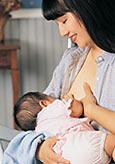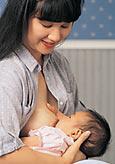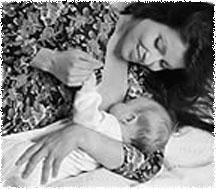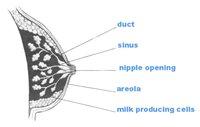Experts, including the American Academy of Pediatrics, agree that breastfeeding is best for babies and best for their mothers. Breastfeeding offers many benefits to the baby.
- Breast milk is very easily and efficiently digested.
- It has the correct balance of nutrients intended for newborns and offers protection against many types of infections, as breast milk contains many anti-infective properties.
- Research shows that breastfed infants have fewer and shorter episodes of illness.
- Your first milk, colostrum, has especially high levels of antibodies and infection fighting cells. This protection can be tailor-made according to the pathogens you encounter in your environment.
- Colostrum is also a gentle, natural laxative that helps clear baby's intestine, decreasing the chance for jaundice to occur.
- Many mothers also experience a sense of bonding and closeness with their baby when they breastfeed.
- The skin-to-skin contact encouraged by breastfeeding offers babies greater emotional security and enhances bonding.
- Breastfeeding elicits hormones which relax you and may help you bond with your baby.
- Breastfeeding may also help protect the baby against allergies in the early months.
- Breastfeeding appears to reduce the risk of obesity and hypertension.
- Breastfeeding delays the onset of hereditary allergic disease and lowers the risk of developing allergic disease.
- Breastfeeding increases the effectiveness of immunizations, increasing the protection against polio, tetanus, and diptheria vaccines.
Breastfeeding also offers many benefits to the mother:
- Breastfeeding causes increased levels of oxytocin, stimulating uterine contractions and minimizing blood loss and encouraging rapid uterine toning.
- From 3 months to 12 months postpartum, breastfeeding increases the rate of weight loss in most nursing mothers.
- Breastfeeding offers some protection against the early return of fertility.
We hope that these pages will help answer many of your breastfeeding questions. For more information, please call 251.340.7770 to discuss breastfeeding with our Board Certified Lactation consultants. For information on Breastfeeding education see our Breastfeeding classes information. You can also download our handout Tips on Breastfeeding at Home.
How Breastfeeding Works
Your milk is made by many clusters of milk-producing cells which fill the back of your breast. From each of these clusters runs a tiny tube (duct) that carries the milk forward. The ducts empty milk into small pockets, called sinuses, beneath the areola. Each sinus narrows down to another tiny tube which goes to a nipple opening. You have about 15 to 20 of these openings.
How Often - How Long
You may begin breastfeeding your baby for ten minutes on each breast, although some babies tire before this time is finished. Once your milk is in, your infant may nurse as long as he or she likes and will need to nurse every two to three hours. Some babies nurse more often than others. Watch your baby for feeding cues such as mouthing, rooting, and sucking motions.
Remember that breastfeeding works on a supply-and-demand system. The more your baby nurses, the more milk you will have. Conversely, the less your baby nurses, the less milk you will have. The process of the baby breastfeeding releases hormones which help you make more milk.
Nursing Positions

The cradle position is the position you will normally use. Be sure you are well supported with pillows under your arms, under the baby, and preferably a stool to lift your legs. Lean back; do not lean over the baby. Make sure your baby faces you squarely.

The football hold is best if you have a baby who is having difficulty latching on, or if you have had a Cesarean birth and don’t want the baby on your abdomen. The football hold is also helpful if you have large breasts.

The side-lying position is best when you want to rest while nursing, or if you are not comfortable sitting. Your arm may rest under the baby’s head or not, as suits you and your baby.
Positioning the baby at the breast.
- Hold your baby’s head close to your breast and lightly touch your nipple to the baby’s lower lip.
- Lift your breast to the baby’s mouth.
- Quickly and firmly pull the baby’s head to your breast.
- Use your finger to assist in releasing your breast from the baby’s mouth.
Key Points to Remember
- Your baby may need to learn to nurse, so be patient and give him or her lots of loving encouragement.
- Avoid unnecessary bottles in the early weeks as these can confuse your baby. If your baby needs supplements in the hospital, the Nursery nurse will let you know.
- You will have colostrum for about three days, which is tailor-made to nourish a newborn. Around the third day after birth, your milk will begin to come in. Your breasts may feel full, warm, tender, and may leak milk from one or both nipples.
- Let your baby signal his hunger, every two hours or so, but don’t let him go much over three hours between feedings after your milk is in, because breast milk is rapidly digested, and your baby may be too tired to signal his hunger.
- After your milk is in, around the third postpartum day, your baby should be having 6-8 wet diapers and more than two bowel movements in each 24-hour period. If he isn’t, call your pediatrician and/or the SMC lactation consultant.
Taking Care of Yourself
Most mothers find that their milk “comes in” around the third day after delivery. Some find that it does not come in until the fourth or fifth day. This is all normal. You will have a small amount of colostrum initially, but remember that it is a very concentrated food, adequate for the baby’s needs. When your milk comes in, you may find that your breasts get larger, fuller, and may be painful. It is essential to keep nursing through this period to keep up the milk supply.
Occasionally mothers find that their nipples are very sore. Some soreness is normal, but a lot of pain while breastfeeding may indicate that the baby is not positioned properly or is not latched on properly to the breast. Call for help if this happens to you.
It is important to take good care of yourself while breastfeeding. Try to rest when your baby rests. It is tempting to try to do housework, but if your baby breastfeeds every two hours, you will need to get your rest in somehow. Try to eat well and drink plenty of fluids. Don’t worry too much about the food you eat upsetting your baby; just eat a well balanced diet and avoid caffeine. You will probably find that if you are careful to restrict your fat intake and you get some aerobic exercise daily, such as walking, that the weight you gained during pregnancy will drop off without much additional effort. It is not the time to begin a dramatic weight loss program, but rather take the slow, steady approach.
Ask For Help
If you need additional help, SMC has board-certified lactation specialists on staff. You may call any time for help with breastfeeding, even after you have been discharged. SMC also provides assistance with breast pump rentals. You may call one of our Lactation Consultants at 251.340.7770 or the main hospital switchboard at 251.344.9630 to access these services. And, our Lactation Consultant is available to answer questions via e-mail at LactationConsult@springhill.org.


